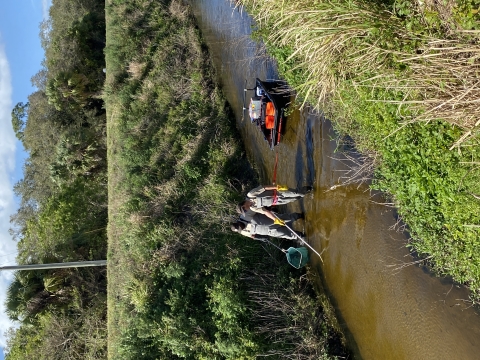Florida's freshwater environments are host to an interesting fish fauna consisting of amazing native species as well as many beautiful nonindigenous species. The freshwater environments in Florida that these fish call home are just as wild and diverse as the fish themselves. Lakes and ponds, rivers and streams, springs, wetlands, canals, ditches and reservoirs are just some freshwater habitats that make up the over 11 million acres of freshwater in the state. With that understood it is important to remember the levels of interconnectivity these bodies of water have with each other, and with the coastal marine environment.
One of the main modes of connectivity between Florida’s water bodies is one mentioned earlier, canals. Florida’s canal system is dense, and diverse with purpose. Canals are artificial waterways that modify existing rivers or streams; or are dug into wetlands or uplands for the purpose of navigation, drainage and flood control, irrigation, access, and recreation. The state is now home to thousands of miles of canals and their water-control structures that are carved into Florida's landscape, especially in the southeastern parts of the state. This system has canals that range from a few feet to hundreds of feet wide, and from a few feet to as deep as 35 feet. These water bodies are full of dams, locks, culverts, and weirs regulating movement and flow. While also being heavily controlled for aquatic plant management and removal.
Working as a Fish Biologist in South Florida one must have as diverse an arsenal of sampling tools and survey methods as the fish and water bodies themselves. Even with electrofishing boats, backpacks, traps, seines, and hook and line, staff at the Peninsular Florida Fish and Wildlife Conservation Office (FWCO) found themselves unable to effectively sample one of the most prevalent habitats in their area, the coastal Florida canal. Steep banks, limited access, and unpredictable water levels make boat electrofishing and many net techniques unfeasible. While high water conductivities (a measure of the ability of water to pass an electrical current) render battery powered backpack electrofishers ineffective.
Due to this gap in sampling effectiveness the crew at the Peninsular Florida FWCO set out to build an electrofishing barge or mini-boat. A sampling method that provides the maneuverability, flexibility, and maximum power needed to navigate and survey this expansive canal system. The reduced size in comparison to an electrofishing boat would allow for easy access into most any situation and can be towed or pushed through the canal during use. Do not let the name “mini-boat” fool you as it is not made for anyone to sit in. The only companions the mini-boat or e-barge will be carrying down the canal are a high-powered generator, electrofishing control box, and tubs and tools for collection. Having the ability to bring a 6000-watt generator and electrofishing control box into these hard to access canals gives the team the maximum power needed to electrofish in these high conductivity waters. Electrofishing barges are available through outside retailers, although at a price steeper than the canal banks the crew is trying to traverse.
With this and a tight budget the Peninsular Florida FWCO team set out to build their own. With an extra-large ice fishing sled (“You want the ice fishing sled shipped where?”), galvanized sheet metal, plywood, and recycled and reimagined equipment a e-barge was built. Add in some safety modifications to an electrofishing control box, lots of wiring, and a 6000-watt generator and it was almost done. After a dry run with an empty mini-boat the team felt comfortable loading it up and lowering it down the steep canal bank directly across from one of South Florida's jungle themed mini golfs. The inaugural journey of the e-barge had begun, with the generator humming behind them fish biologists Cedric Doolittle and Eddie Perri set power outputs according to local conductivities and shocked away. Not only did the e-barge outperform its expectations but it was only using a small amount of the potential power it had to offer. After a few more in-situ tests a surprising discovery was made. The team collected a yellow belly cichlid (Cichlasoma salvini) which was well out of its previous known range. Other fish encountered were Mayan cichlid (Cichlasoma urophthalmus), jewel cichlid (Hemichromis letourneuxi), American eels (Anguilla rostrata), blackchin tilapia (Sarotherodon melanotheron), and Florida gar (Lepisosteus platyrhincus). The yellow belly cichlid, which is native to Atlantic slope drainages from Mexico to Guatemala, was a surprise as this beautifully colored fish was thought to have occurred only in Southern Broward County (125+ miles south of our sampling site) and West of Broward County into the Everglades. This discovery would signify a significant range expansion of this aquatic invasive species invasive species
An invasive species is any plant or animal that has spread or been introduced into a new area where they are, or could, cause harm to the environment, economy, or human, animal, or plant health. Their unwelcome presence can destroy ecosystems and cost millions of dollars.
Learn more about invasive species (AIS). Have many AIS ranges been underestimated, or AIS gone undetected in these under-surveyed water bodies of South Florida? With the new e-barge filling in a gap in the Peninsular Florida FWCO’s survey equipment the staff hope to utilize it to fill in gaps in South Florida’s fisheries data.




